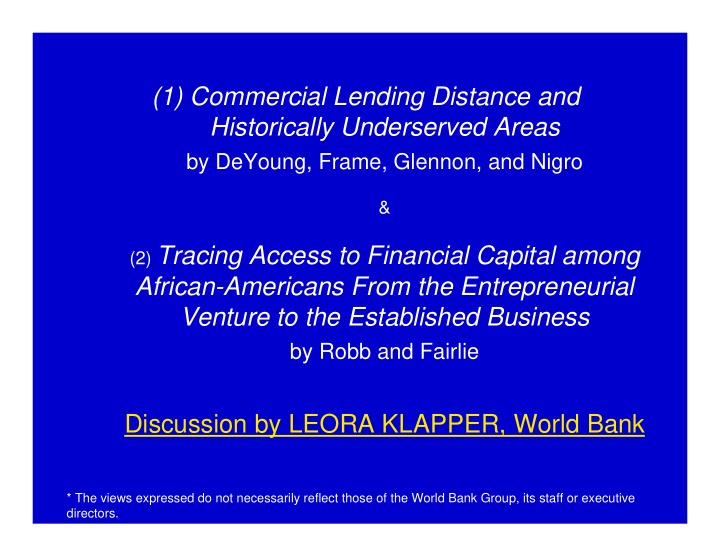



(1) Commercial Lending Distance and Historically Underserved Areas by DeYoung, Frame, Glennon, and Nigro & (2) Tracing Access to Financial Capital among African-Americans From the Entrepreneurial Venture to the Established Business by Robb and Fairlie Discussion by LEORA KLAPPER, World Bank * The views expressed do not necessarily reflect those of the World Bank Group, its staff or executive directors.
Commercial Lending Distance… • The growth in SME credit scoring has led to an increase in “distance” between borrowers and lenders, particularly in low-income and minority neighborhoods – “Personal Credit Scores” measure default probability of the owner/manager, such as payment histories on retail purchases, personal credit cards, mortgages, etc. – “Business Survival Scores” measure the probability of business failure, i.e. management quality, business viability, and industry risk (e.g., Genesis Score) • Variations found in many emerging markets: – India (“Citibusiness”) – South Africa (“e-banks”)
Commercial Lending Distance… • OR…do borrowers in LI neighborhoods have less access to financial institutions? – Evidence that the number of branches has increased over time • But where are new branches opening? • Is disaggregated branch penetration data available? – Positive relationship between distance and loan size and negative relationship with SBA • Are fewer loans being made to smaller, riskier borrowers?
Commercial Lending Distance… • Do minority small business owners have access to the internet (or are they traveling 40-plus miles to visit a distant bank branch?) – Was any technological assistance offered to entrepreneurs in the late 1990s? • What is the impact on entrepreneurs with limited credit histories, i.e., borrowers who loans might be based on “soft” information/relationships with loan officers?
Tracing Access to Finance… • Lower levels of financial access among African- Americans is related to relatively lower rates of entrepreneurship Figure 6: Entry rates and private credit Entry rates 20% 15% 10% 5% 0% 0 50 100 150 200 PC/GDP Coefficent=0.026 p-value=0.006 R=0.117 N=62
Tracing Access to Finance… • A growing international literature linking access to finance and entrepreneurship • Paulson and Townsend (2005=4, 2006), Djankov et al., 2005; 2006a; 2006b , 2007, Demirguc-Kunt, Klapper, and Panos (2007), Quadrini (2000), etc. • Entrepreneurship is related to access to financial services, as well as personal wealth, savings, home ownership, etc. – Winners of “Windfall gains” are more likely to enter self-employment and remain successfully self- employed, e.g. Sweden, U.K. and the U.S. • Lindh and Ohlsson, 1996; Taylor, 1999; Blanchflower and Oswald, 1998; Holtz-Eakin et al., 1994a; 1994b).
“The differences in credit use and borrowing history might be explained by the poor credit histories of these black-owned businesses” • Do we have data/evidence?? • South African experience: – Are credit scores discriminatory… NO! • Improved consumer education: – Helping low-income and minority communities get access to and understand their credit scores – Assistance on how to improve credit scores – General assistance with financial literacy – Access to electronic loan applications
Recommend
More recommend